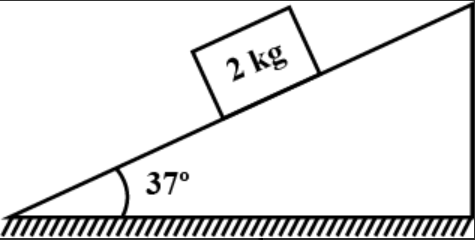A block of wood of 1 kg resting on an inclined plane of angle 30∘, just starts moving down. If the coefficient of friction is 0.2, then find its velocity (in ms−1) after 5 s (take , g=10ms−2)
To solve the problem step by step, we will analyze the forces acting on the block of wood on the inclined plane and calculate the acceleration first, then use that to find the velocity after 5 seconds.
Step 1: Identify the forces acting on the block
The forces acting on the block are:
- Gravitational force (weight) acting downwards: W=mg
- Normal force acting perpendicular to the inclined plane
- Frictional force acting upwards along the plane
Step 2: Calculate the weight of the block
Given:
- Mass m=1kg
- Acceleration due to gravity g=10m/s2
The weight of the block is:
W=mg=1×10=10N
Step 3: Resolve the weight into components
The weight can be resolved into two components:
- Perpendicular to the inclined plane: W⊥=mgcosθ
- Parallel to the inclined plane: W∥=mgsinθ
For θ=30∘:
W⊥=10cos30∘=10×√32=5√3N
W∥=10sin30∘=10×12=5N
Step 4: Calculate the normal force
The normal force N is equal to the perpendicular component of the weight:
N=W⊥=5√3N
Step 5: Calculate the frictional force
The frictional force Ff can be calculated using the coefficient of friction μ:
Ff=μN=0.2×5√3=√3N
Step 6: Calculate the net force acting on the block
The net force Fnet acting down the incline is given by:
Fnet=W∥−Ff=5−(0.2×5√3)
Substituting the value of Ff:
Fnet=5−√3N
Step 7: Calculate the acceleration of the block
Using Newton's second law F=ma:
ma=Fnet
a=Fnetm=5−0.2×5√31
a=5−√3m/s2
Step 8: Calculate the velocity after 5 seconds
Using the equation of motion:
v=u+at
Where:
- Initial velocity u=0
- Time t=5s
Substituting the values:
v=0+(5−√3)×5
v=25−5√3m/s
Final Calculation
Using √3≈1.732:
v≈25−5×1.732≈25−8.66≈16.34m/s
Thus, the velocity of the block after 5 seconds is approximately:
16.34m/s
The forces acting on the block are:
- Gravitational force (weight) acting downwards: W=mg
- Normal force acting perpendicular to the inclined plane
- Frictional force acting upwards along the plane
Given:
- Mass m=1kg
- Acceleration due to gravity g=10m/s2
W=mg=1×10=10N
The weight can be resolved into two components:
- Perpendicular to the inclined plane: W⊥=mgcosθ
- Parallel to the inclined plane: W∥=mgsinθ
W⊥=10cos30∘=10×√32=5√3N
W∥=10sin30∘=10×12=5N
The normal force N is equal to the perpendicular component of the weight:
N=W⊥=5√3N
The frictional force Ff can be calculated using the coefficient of friction μ:
Ff=μN=0.2×5√3=√3N
The net force Fnet acting down the incline is given by:
Fnet=W∥−Ff=5−(0.2×5√3)
Fnet=5−√3N
Using Newton's second law F=ma:
ma=Fnet
a=Fnetm=5−0.2×5√31
a=5−√3m/s2
Using the equation of motion:
v=u+at
Where:
- Initial velocity u=0
- Time t=5s
v=0+(5−√3)×5
v=25−5√3m/s
Using √3≈1.732:
v≈25−5×1.732≈25−8.66≈16.34m/s
16.34m/s
Similar Questions
Knowledge Check
- Question 1 - Select One
A block of mass m=2kg is resting on a rough inclined plane of inclination of 30∘ as shown in figure. The coefficient of friction between the block and the plane is μ=0.5. What minimum force F should be applied perpendicular to the plane on the block, so that blocks does not slip on the plane? (g=10m/s2)
 A2.68 NBZeroC4.34 ND6.24 N
A2.68 NBZeroC4.34 ND6.24 N
Block of mass 10 kg is moving on inclined plane with constant velocity 10 m/s. The coedfficient of kinetic friction between incline plane and block is :-
View SolutionA block of mass 1 kg slides down a rough inclined plane of inclination 60∘ starting from its top. If coefficient of kinetic is 0.5 and length of the plane d=2 m, then work done against friction is
View SolutionA block of mass 2 kg slides down an incline plane of inclination 30°. The coefficient of friction between block and plane is 0.5. The contact force between block and plank is :
View SolutionA block slide down an incline of angle 30∘ with an acceleration g/4. Find the kinetic friction coefficient.
View SolutionA mass of 200kg is resting on a rough inclined plane of angle 30∘. If the coefficient of friction is 1/√3 , find the greatest and the least force acting parallel to the plane which can just maintain the mass in equilibrium.
View SolutionA block of mass 2kg lying on ice when given a velocity of 6ms−1 is stopped by friction in 5s. The coefficient of friction between the block and ice is (g=10 ms−2)
View SolutionA block of mass 2kg is pushed down an inclined plane of angle 37∘ above horizontal with a force parallel to inclined plane. The coefficient of friction is 3/4. The block moves 10m in 2 seconds starting form rest. The magnitude of the force is
View Solution



